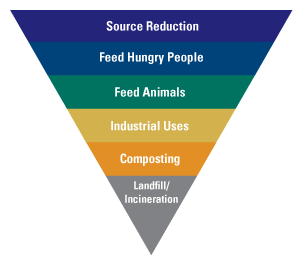Before this blog delves too far into specifics, we should talk about general guidelines on what to do with existing food waste. The EPA has set a nice standard with its Food Waste Recovery Hierarchy. As seen in the snazzy pyramid graphic below, here’s how they propose handling excess food (in order of preference):
That means the worst case scenario is sending food to the landfill or incinerating it. This is because the plastic trash bags keep food from rejoining the earth. Also, a giant trash heap creates a boatload of methane, a greenhouse gas. Food is the largest component of America’s waste stream and landfills are the nation’s largest source of methane emissions.
I especially like the first rule for handling waste–don’t create it in the first place. Here’s where you can tell that this hierarchy was produced by the EPA and not the Department of Agriculture or any other ag industry folks, who seem to emphasize abundance.
Reduction is an admirable goal, but it seems to be easier said than done? One key to mimizing waste is predicting demand. The restaurant industry, and particularly fast food sector, have become better at this. Their main problem is that they often don’t have the shrewd managers needed to implement that forecasting. Plus, unpredictable factors like weather and traffic affect business. And restaurants never want to run out–chains see that as one of the worst things that can happen. As a result, they must keep extra on hand. They still waste 10 percent of their food, according to Timothy Jones, a University of Arizona anthropologist.
Of course, the reduction rule applies to you folks at home, too. Given that we tend to waste about 25 percent of our groceries, we should probably think through our supermarket purchases a bit more. In other words, make a list and try not to be swayed into impulse buys.

2 Comments